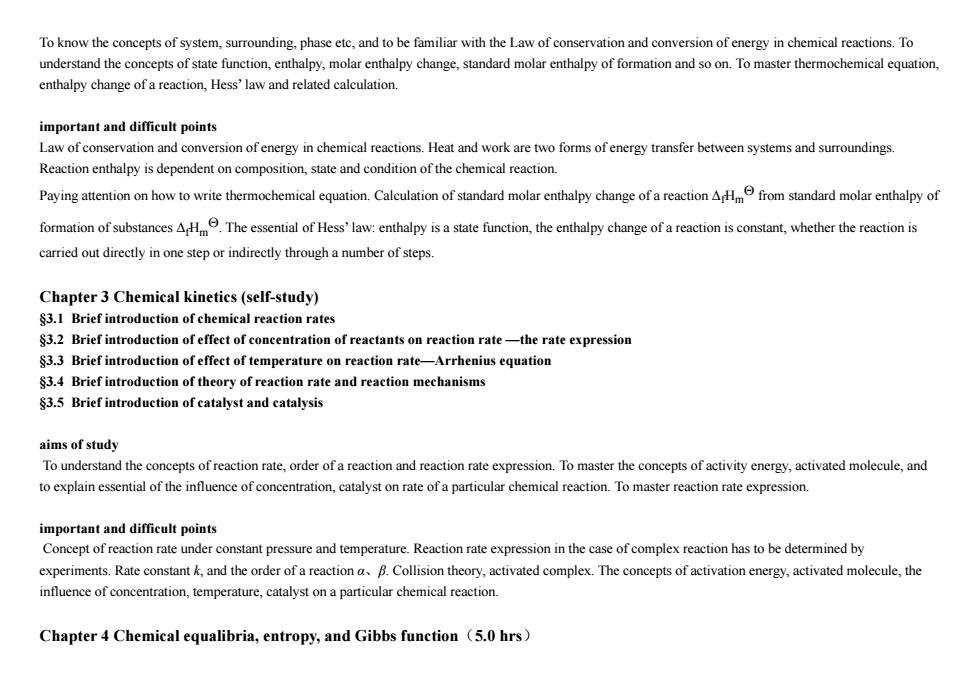正在加载图片...

To know the concepts of system,surrounding,phase etc,and to be familiar with the Law of conservation and conversion of energy in chemical reactions.To understand the concepts of state function,enthalpy,molar enthalpy change,standard molar enthalpy of formation and so on.To master thermochemical equation, enthalpy change of a reaction,Hess'law and related calculation. important and difficult points Law of conservation and conversion of energy in chemical reactions.Heat and work are two forms of energy transfer between systems and surroundings. Reaction enthalpy is dependent on composition,state and condition of the chemical reaction. Paying attention on how to write thermochemical equation.Calculation of standard molar enthalpy change of a reaction Afrom standard molar enthalpy of formation of substancesA The essential of Hess'law:enthalpy is a state function,the enthalpy change of a reaction is constant,whether the reaction is carried out directly in one step or indirectly through a number of steps Chapter 3 Chemical kinetics(self-study) $3.1 Brief introduction of chemical reaction rates $3.2 Brief introduction of effect of concentration of reactants on reaction rate-the rate expression $3.3 Brief introduction of effect of temperature on reaction rate-Arrhenius equation $3.4 Brief introduction of theory of reaction rate and reaction mechanisms $3.5 Brief introduction of catalyst and catalysis aims of study To understand the concepts of reaction rate,order of a reaction and reaction rate expression.To master the concepts of activity energy,activated molecule,and to explain essential of the influence of concentration,catalyst on rate of a particular chemical reaction.To master reaction rate expression. important and difficult points Concept of reaction rate under constant pressure and temperature.Reaction rate expression in the case of complex reaction has to be determined by experiments.Rate constant k,and the order of a reaction a.B.Collision theory,activated complex.The concepts of activation energy,activated molecule,the influence of concentration,temperature,catalyst on a particular chemical reaction. Chapter 4 Chemical equalibria,entropy,and Gibbs function (5.0 hrs)To know the concepts of system, surrounding, phase etc, and to be familiar with the Law of conservation and conversion of energy in chemical reactions. To understand the concepts of state function, enthalpy, molar enthalpy change, standard molar enthalpy of formation and so on. To master thermochemical equation, enthalpy change of a reaction, Hess’ law and related calculation. important and difficult points Law of conservation and conversion of energy in chemical reactions. Heat and work are two forms of energy transfer between systems and surroundings. Reaction enthalpy is dependent on composition, state and condition of the chemical reaction. Paying attention on how to write thermochemical equation. Calculation of standard molar enthalpy change of a reaction ΔfHm Q from standard molar enthalpy of formation of substances ΔfHm Q. The essential of Hess’ law: enthalpy is a state function, the enthalpy change of a reaction is constant, whether the reaction is carried out directly in one step or indirectly through a number of steps. Chapter 3 Chemical kinetics (self-study) §3.1 Brief introduction of chemical reaction rates §3.2 Brief introduction of effect of concentration of reactants on reaction rate —the rate expression §3.3 Brief introduction of effect of temperature on reaction rate—Arrhenius equation §3.4 Brief introduction of theory of reaction rate and reaction mechanisms §3.5 Brief introduction of catalyst and catalysis aims of study To understand the concepts of reaction rate, order of a reaction and reaction rate expression. To master the concepts of activity energy, activated molecule, and to explain essential of the influence of concentration, catalyst on rate of a particular chemical reaction. To master reaction rate expression. important and difficult points Concept of reaction rate under constant pressure and temperature. Reaction rate expression in the case of complex reaction has to be determined by experiments. Rate constant k, and the order of a reaction α、β. Collision theory, activated complex. The concepts of activation energy, activated molecule, the influence of concentration, temperature, catalyst on a particular chemical reaction. Chapter 4 Chemical equalibria, entropy, and Gibbs function(5.0 hrs)